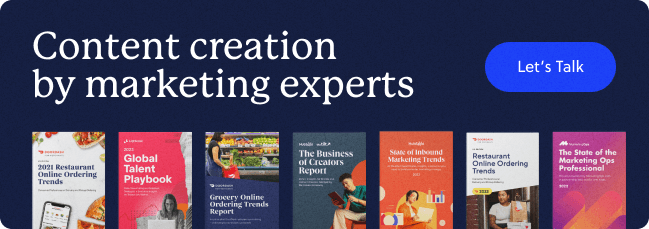Apple just announced the launch of the Vision Pro, a mixed reality wearable headset — what does it mean for brand marketing teams?
The Vision Pro headset is what we picture when we think of the future of communication. It’s a hands-free headset that creates an immersive experience where the user can navigate the web, watch videos, send emails, and do anything they want online while viewing it on their own personal projector. Apple is calling it “spatial computing”.
Looking for content marketing support for your brand? We can help. Let’s Talk

Source: TechCrunch
It’s currently a bit pricey ($3,500) but the Vision Pro announcement from Apple generated tons of buzz, particularly about the future of communication.
Many brands thought that the Metaverse was going to be a similar type of revolutionary technology, with companies like Walmart developing Metaverse stores and shopping experiences. But after spending $36B to develop the technology, Meta has been operating at a massive loss, with no profits to show and underwhelming user engagement.
Will this be the VR headset and mixed reality experience that changes how we live, work, and have fun?
AR and VR marketing experiences are still new, but gaining interest
From a marketing perspective, it’s still early for your average brand to be developing mixed reality or spatial computing-friendly content. The AR/VR headset market is predicted to grow 14% in 2023 and pick up even more through 2027, with virtual reality devices far surpassing augmented reality ones.
Brands need to plan ahead for how mixed reality devices will change content consumption
A few moments from the Vision Pro demo stood out as key takeaways for marketing teams.
First — virtual reality screens. They’re larger than life. And much larger than a phone screen, or a 13” — 17” laptop screen, or even a giant monitor. Apple’s VR screens can fill up a whole room. Second — interactive experiences have so many new possibilities. Users can physically engage with their surroundings and interact with others in a virtual environment. And third — accessibility is becoming even more … accessible. Marketers can now optimize brand experiences for people of all abilities, like those who are hard of hearing.
When thinking about spatial computing and mixed reality, here’s where we’ll see the first changes to the consumer experience.
Changes to the web experience
Users won’t scroll through pages and open links in new tabs anymore with VR headsets. They’ll swipe, open new windows side by side, and access a more immersive experience with what they’re reading. This will impact site navigation and overall content consumption.
Changes to design requirements
Designers will need to think big. Everything will need to be automatically responsive with vector files and hard-coding everywhere. Nothing can risk losing quality when stretching to larger-than-life dimensions.
New dev needs
With this new technology, developers will become an even more critical part of the marketing and web team. Every page will need to be optimized for a smooth VR experience and there are new technical considerations for the swiping mechanisms of spatial computing.
Storytelling will be even more important
Storytelling has always been a helpful differentiator for brands to reach a wider audience and build better connections with their followers. And for companies that rely on data to educate and convert their customers, data storytelling is an even harder challenge.
Even as early as 2012, media publishers like the New York Times were rethinking long-form content with interactive, story-driven pieces like Snow Fall. In a world where most content is consumed through interactive VR headsets, storytelling will become the highest priority.
Brands will look at engagement more closely than conversions
On a traditional device, the way that brands understand who is most interested in working with them consists of tracking who filled out forms to get more information and analyzing different conversion points in the buyer’s journey.
When people engage using AR and VR devices, their engagement is the sign of intent. Time spent on page will become a more important metric, along with shares and saves.
Here’s where brands should start with AR, VR, and mixed reality marketing
- Rethink your web and content experiences.
Don’t map out your whole strategy around web, mobile, and tablet experiences. Think universal with responsive content that’s easy to read and access on any device, anywhere. Consider how you can bring interactivity and storytelling into every piece of content to prepare for a more immersive experience.
- Bring mixed reality experiences to events with interactive product demos.
This year, it might not make sense to invest in dozens of Vision Pro headsets for your marketing, brand, and events teams. Try piloting an interactive demo on a Vision Pro at your next event. See how you can bring the novelty of this new technology to a brand promotion opportunity and get more people to learn about your platform.
- Address accessibility across all content and product experiences.
With Apple’s newest operating system, iOS 17, accessibility is built into every operation. New features include Live Speech — real-time transcriptions of spoken language — and Assistive Access which lightens the user’s cognitive load. Point and speak will help those with low vision capabilities navigate their devices more easily.

Source: Apple
Most brands already know how to incorporate the universally-accepted Web Content and Accessibility Guidelines (WCAG) into their content strategy, but there’s a new frontier in accessibility standards coming. The brands who incorporate the most up-to-date accessibility features in their content will reach wider audiences and provide a better experience that keeps people coming back.
So, is Apple’s new VR headset going to cause a boom in mixed reality marketing campaigns?
You heard it here first, folks. There’s a revolution in the content experience and storytelling coming. The Apple Vision Pro seems to be the first of its kind that might actually stick around and change the way people read, “scroll”, learn, and communicate. For now, think about how you can start to plant seeds of change in your content marketing strategy that will ultimately lead to better immersive experiences in the future.








